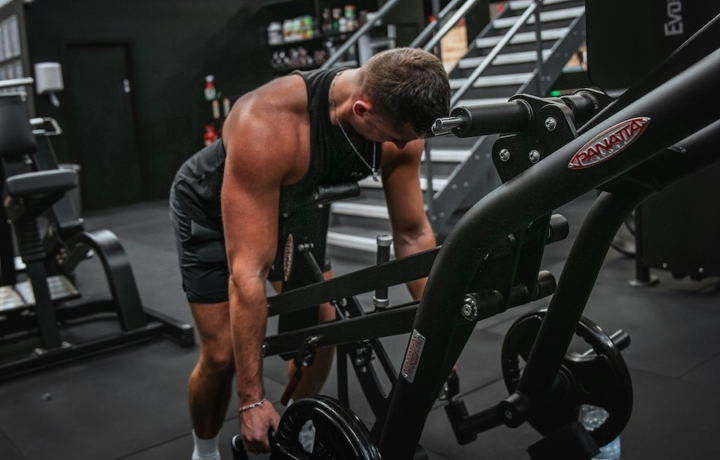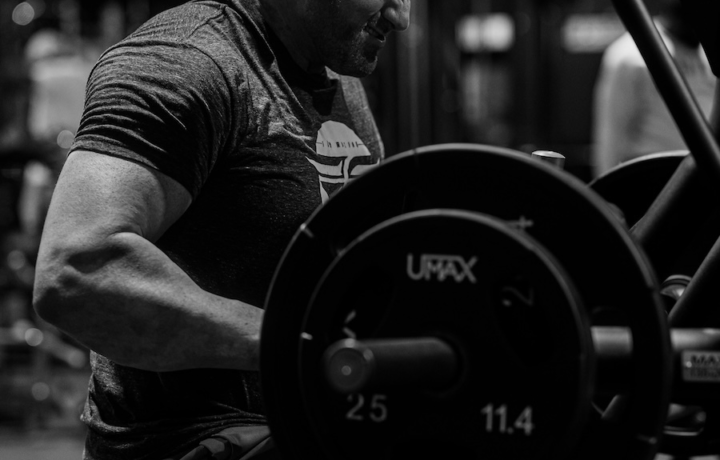Exercise
Bent Over Dumbbell Row

Bent Over Dumbbell Row
How to Perform
- Select an appropriate weight dumbbell and stand with your feet shoulder-width apart, knees slightly bent to maintain a stable base.
- Hinge at your hips while keeping your back flat until your torso is parallel to the ground or at a 45-degree angle, allowing the dumbbells to hang directly beneath your shoulders.
- Position your hands in a neutral grip (palms facing each other) with arms fully extended and shoulders pulled back and down to protect your rotator cuff.
- Brace your core and maintain a slight arch in your lower back to protect your spine throughout the movement.
- Exhale as you pull the dumbbells toward your lower ribcage, keeping your elbows close to your body and driving them toward the ceiling.
- Squeeze your shoulder blades together at the top of the movement while keeping your torso stationary.
- Inhale as you slowly lower the weights back to the starting position with controlled movement, fully extending your arms.
- Repeat for the prescribed number of repetitions, maintaining your hinged position and neutral spine throughout the entire set.
Important information
- Keep your neck aligned with your spine by looking at a spot on the floor a few feet in front of you rather than lifting your head up.
- Avoid using momentum or swinging your torso to move the weight—the power should come from your back muscles, not body rocking.
- If you feel the exercise in your lower back instead of your upper back, reduce the weight and focus on proper form.
- Make sure your wrists remain neutral (not flexed or extended) throughout the entire movement to prevent strain.

Bent Over Dumbbell Row
Exercise Details
Primary Muscles
Muscle Groups
Mechanic
Risk Areas
Built for progress
Take the guesswork out of training
Create personalized AI-powered workout plans that evolve with you. Train smarter, track every rep and keep moving forward, one workout at a time.






The Bent Over Dumbbell Row stands as a cornerstone back exercise that delivers impressive results for anyone looking to develop serious upper body strength and definition. This intermediate movement primarily targets the latissimus dorsi (lats), trapezius muscles (traps), and biceps, making it an exceptional compound exercise for building a powerful, V-shaped torso. When incorporated into bodybuilding routines, the Bent Over Dumbbell Row allows for precise control and range of motion that barbell variations sometimes lack. The unilateral nature of working with dumbbells helps identify and correct strength imbalances between sides, ensuring symmetrical development across your back.
Many elite bodybuilders rely on this movement to sculpt detailed back musculature, particularly in the middle and lower trapezius regions. The versatility of this exercise also makes it a natural fit for High-Intensity Interval Training (HIIT) protocols. By adjusting the weight and tempo, you can transform this strength-focused movement into a metabolic powerhouse that elevates heart rate while building muscle. The dual benefit of strength and conditioning makes it particularly efficient for those with limited training time. From a strength perspective, the Bent Over Dumbbell Row develops functional power that translates to improved performance in everyday activities and other exercises. The stabilization demands placed on your core create a comprehensive strength challenge that goes well beyond just back development. Research has shown that row variations significantly contribute to improved posture and reduced risk of back injuries by strengthening the posterior chain.
The beauty of this exercise lies in its adaptability: it can be modified to emphasize different areas of the back by simply adjusting your elbow path or grip position. Whether you're looking to add serious mass to your frame or develop the defined, sculpted back that turns heads, the Bent Over Dumbbell Row deserves a prominent place in your training arsenal.
FAQ - Bent Over Dumbbell Row
The Bent Over Dumbbell Row primarily targets the latissimus dorsi (lats), rhomboids, and trapezius muscles, while also engaging the biceps, rear deltoids, and erector spinae as secondary movers. Your core muscles work isometrically throughout the movement to maintain proper posture.
Hinge at your hips to create a 45-degree torso angle with a flat back, keeping your core tight and knees slightly bent. Pull the dumbbells up by driving your elbows toward the ceiling, squeezing your shoulder blades together at the top, and lowering with control while maintaining your hinged position.
Beginners can use lighter weights and a more upright torso position (around 30 degrees) to reduce lower back strain. Advanced lifters can increase weight, add tempo variations (like 3-second negatives), or try single-arm versions with heavier loads to increase intensity and challenge core stability.
Avoid rounding your lower back, which increases injury risk, and resist the urge to use momentum by swinging your torso. Don't pull with just your arms—focus on driving the movement from your back muscles by leading with your elbows, not your hands or wrists.
Include Bent Over Dumbbell Rows 1-2 times weekly with at least 48 hours between sessions targeting the same muscle groups. For hypertrophy, aim for 3-4 sets of 8-12 reps with moderate weight; for strength, perform 3-5 sets of 4-6 reps with heavier weight.








